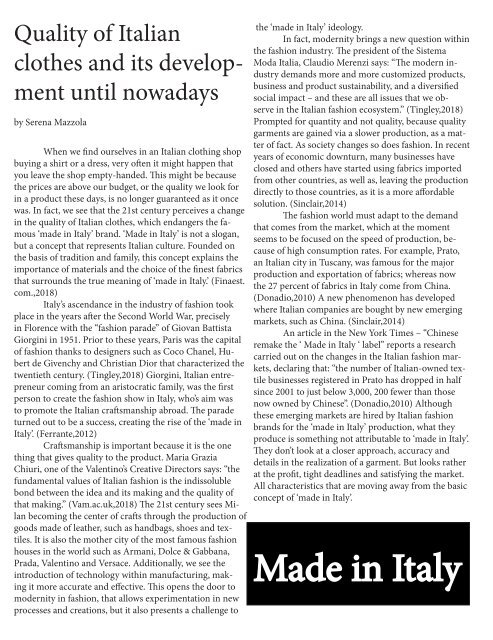RUONCAMPUS MAGAZINE FINAL Version
You also want an ePaper? Increase the reach of your titles
YUMPU automatically turns print PDFs into web optimized ePapers that Google loves.
Quality of Italian<br />
clothes and its development<br />
until nowadays<br />
by Serena Mazzola<br />
When we find ourselves in an Italian clothing shop<br />
buying a shirt or a dress, very often it might happen that<br />
you leave the shop empty-handed. This might be because<br />
the prices are above our budget, or the quality we look for<br />
in a product these days, is no longer guaranteed as it once<br />
was. In fact, we see that the 21st century perceives a change<br />
in the quality of Italian clothes, which endangers the famous<br />
‘made in Italy’ brand. ‘Made in Italy’ is not a slogan,<br />
but a concept that represents Italian culture. Founded on<br />
the basis of tradition and family, this concept explains the<br />
importance of materials and the choice of the finest fabrics<br />
that surrounds the true meaning of ‘made in Italy.’ (Finaest.<br />
com.,2018)<br />
Italy’s ascendance in the industry of fashion took<br />
place in the years after the Second World War, precisely<br />
in Florence with the “fashion parade” of Giovan Battista<br />
Giorgini in 1951. Prior to these years, Paris was the capital<br />
of fashion thanks to designers such as Coco Chanel, Hubert<br />
de Givenchy and Christian Dior that characterized the<br />
twentieth century. (Tingley,2018) Giorgini, Italian entrepreneur<br />
coming from an aristocratic family, was the first<br />
person to create the fashion show in Italy, who’s aim was<br />
to promote the Italian craftsmanship abroad. The parade<br />
turned out to be a success, creating the rise of the ‘made in<br />
Italy’. (Ferrante,2012)<br />
Craftsmanship is important because it is the one<br />
thing that gives quality to the product. Maria Grazia<br />
Chiuri, one of the Valentino’s Creative Directors says: “the<br />
fundamental values of Italian fashion is the indissoluble<br />
bond between the idea and its making and the quality of<br />
that making.” (Vam.ac.uk,2018) The 21st century sees Milan<br />
becoming the center of crafts through the production of<br />
goods made of leather, such as handbags, shoes and textiles.<br />
It is also the mother city of the most famous fashion<br />
houses in the world such as Armani, Dolce & Gabbana,<br />
Prada, Valentino and Versace. Additionally, we see the<br />
introduction of technology within manufacturing, making<br />
it more accurate and effective. This opens the door to<br />
modernity in fashion, that allows experimentation in new<br />
processes and creations, but it also presents a challenge to<br />
the ‘made in Italy’ ideology.<br />
In fact, modernity brings a new question within<br />
the fashion industry. The president of the Sistema<br />
Moda Italia, Claudio Merenzi says: “The modern industry<br />
demands more and more customized products,<br />
business and product sustainability, and a diversified<br />
social impact – and these are all issues that we observe<br />
in the Italian fashion ecosystem.” (Tingley,2018)<br />
Prompted for quantity and not quality, because quality<br />
garments are gained via a slower production, as a matter<br />
of fact. As society changes so does fashion. In recent<br />
years of economic downturn, many businesses have<br />
closed and others have started using fabrics imported<br />
from other countries, as well as, leaving the production<br />
directly to those countries, as it is a more affordable<br />
solution. (Sinclair,2014)<br />
The fashion world must adapt to the demand<br />
that comes from the market, which at the moment<br />
seems to be focused on the speed of production, because<br />
of high consumption rates. For example, Prato,<br />
an Italian city in Tuscany, was famous for the major<br />
production and exportation of fabrics; whereas now<br />
the 27 percent of fabrics in Italy come from China.<br />
(Donadio,2010) A new phenomenon has developed<br />
where Italian companies are bought by new emerging<br />
markets, such as China. (Sinclair,2014)<br />
An article in the New York Times – “Chinese<br />
remake the ‘ Made in Italy ‘ label” reports a research<br />
carried out on the changes in the Italian fashion markets,<br />
declaring that: “the number of Italian-owned textile<br />
businesses registered in Prato has dropped in half<br />
since 2001 to just below 3,000, 200 fewer than those<br />
now owned by Chinese”. (Donadio,2010) Although<br />
these emerging markets are hired by Italian fashion<br />
brands for the ‘made in Italy’ production, what they<br />
produce is something not attributable to ‘made in Italy’.<br />
They don’t look at a closer approach, accuracy and<br />
details in the realization of a garment. But looks rather<br />
at the profit, tight deadlines and satisfying the market.<br />
All characteristics that are moving away from the basic<br />
concept of ‘made in Italy’.<br />
Made in Italy


